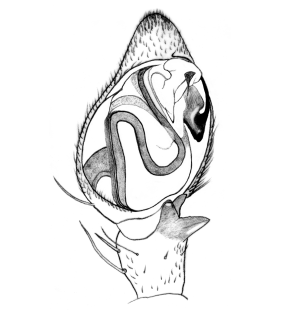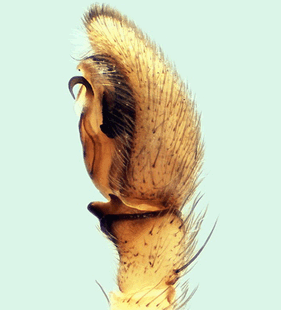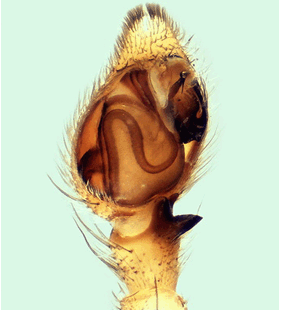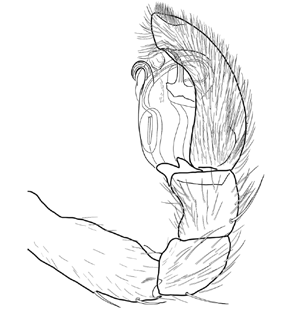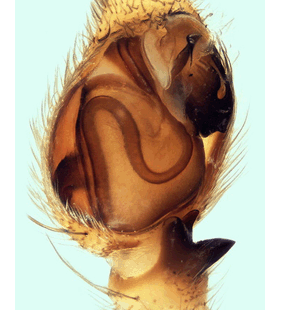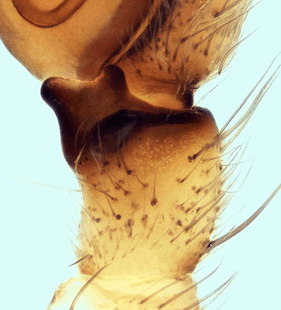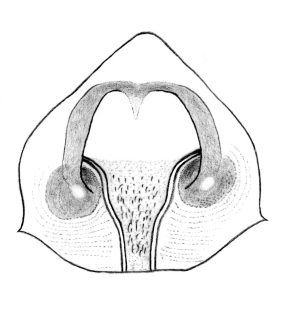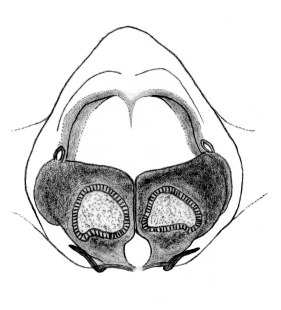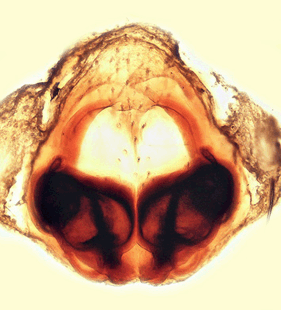Celerrimus duffeyi Lecigne, 2019
Description
Male
Opisthosoma with variable pattern, more or less contrasted.
Leg spination (basal - middle - apical part): femur dorsal 1 - 1 - 1 (sometimes apically a fourth one, very short), tibia ventral 2 (0.15-0.17) - 2 (0.50-0.52) - 2 (0.93) (the third pair shorter), metatarsus ventral 2 - 2 (0.54) - 0, tarsus spineless, variable for the rest.
Pedipalp: Tibia with rounded, thick and broad VTA, RTA sclerotized, arrowhead-like, pointing outward, anterior part almost horizontal, apical part rounded and bent outwards. Cymbium oval, asymmetrical with a remote axis retrolaterally in 1 o’clock position. Conductor process in retrolateral-distal position, highly developed, lamellous and hook-shaped, slightly twisted retrolaterally. Conductor constituting a wide membraneous outgrowth. Embolar base conspicuously widened, the part forming the connection with the embolus very sclerotized. Embolus relatively short, running retrolaterally, originating at 3 o’clock position, quickly narrowing, terminating between 0 and 1 o’clock position.
Body length male: 4.60-5.27 mmFemale
Colour and leg spination as in male.
Epigyne/vulva: epigyne formed in its anterior part by an atrium, wide (0.26-0.30 mm), undivided, with two arches. The median septum constitutes the posterior part, margins strongly slerotized, more or less flared distally, ending in the lateral-proximal parts of the epigynal cavity. Receptacula massive, in contact over their entire inner margin, wider spread than atrium. Very small glandular heads without any ducts, sitting at main body of receptacula, in distal-lateral position, pointing in innerdistal direction.
Body length female: 4.87-6.07 mmAdditional information
The species has been quite frequently observed in pine forest and clearings (especially Pinus nigra) and also in scrubland on Pinus halepensis. But it occurs also in different habitats such as stony meadows with short vegetation (10 cm), the edge of a pond in shrubs (on Pistacia lentiscus) and semi-natural environments like gardens (with trees, e.g., Thuja, Pseudotsuga, Quercus).
Altitude from 20 up to 1210 m.
Distribution
Phenology
| Jan | Feb | Mar | Apr | May | Jun | Jul | Aug | Sep | Oct | Nov | Dec |
 |  |
Figures
Distribution List
"No references" does not mean that the species does not occur in this country, but that we have not yet inserted the reference for it. We are working on it.
References
Breitling R (2020) South European spiders from the Duffey collection in the Manchester Museum (Arachnida: Araneae). Arachnology 18: 333-362 ![]()
Lecigne S, Cornic J-F, Oger P, Van Keer J (2019) Celerrimus n. gen. (Araneae, Philodromidae) et description de Celerrimus duffeyi n. sp., une espèce très singulière d’Europe occidentale. Revue Arachnologique (2) 6: 32-51 ![]()
WSC (2025) World Spider Catalog. Version 26. Natural History Museum Bern, online at http://wsc.nmbe.ch (28.2.2025) doi: 10.24436/2 ![]()
